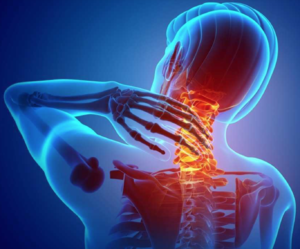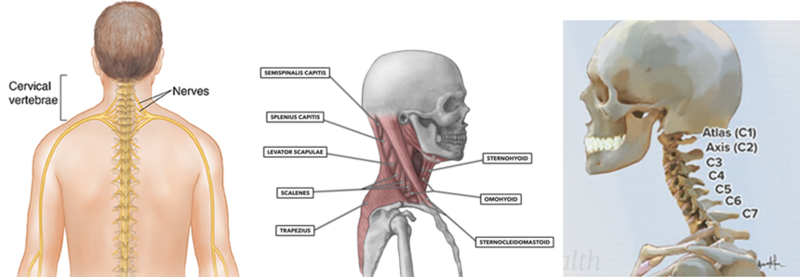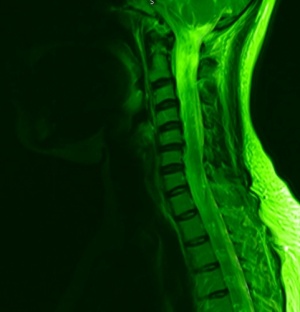Neck Pain: Clinical Practice Guidelines: Difference between revisions
No edit summary |
No edit summary |
||
| Line 234: | Line 234: | ||
- Childress MA, Becker BA. Nonoperative management of cervical radiculopathy. Am Fam Physician. 2016; 93(9):746-54. | - Childress MA, Becker BA. Nonoperative management of cervical radiculopathy. Am Fam Physician. 2016; 93(9):746-54. | ||
- Magee DJ. Cervical Spine. In: Magee DJ, ed. Orthopedic Physical Assessment. 5th ed. St. Louis, MO. Saunders Elsevier; 2008: 130-202.<br> | - Magee DJ. Cervical Spine. In: Magee DJ, ed. Orthopedic Physical Assessment. 5th ed. St. Louis, MO. Saunders Elsevier; 2008: 130-202. | ||
- Kim, R., Wiest, C., Clark, K., Cook, C. and Horn, M., 2018. Identifying risk factors for first-episode neck pain: A systematic review. Musculoskeletal Science and Practice, 33, pp.77-83. | |||
- Trippolini, M., Janssen, S., Hilfiker, R. and Oesch, P., 2017. Measurement Properties of the Modified Spinal Function Sort (M-SFS): Is It Reliable and Valid in Workers with Chronic Musculoskeletal Pain?. Journal of Occupational Rehabilitation, 28(2), pp.322-331.<br> | |||
[[Category:Interventions]] | [[Category:Interventions]] | ||
Revision as of 16:29, 23 May 2021
Original Editors - Chad Adams, Jacob Melnick, & Tyler Shultz
Lead Editors Tyler Shultz, Kim Jackson, Angeliki Chorti, Cindy John-Chu, Eric Robertson, Alexandra Malzer, Dorian Mars, Admin, Jacob Melnick, Evan Thomas, Zachary Cooper, Scott Buxton, WikiSysop, Albert Alabaster, Tony Lowe, Nupur Smit Shah, Chad Adams, Simisola Ajeyalemi, Agoro Bukola Zainab and Rachael Lowe
Discussion & Background[edit | edit source]
The purpose of these clinical guidelines it to describe the new evidence based physical therapy practices including pathoanatomical features, examination, diagnosis/classification, intervention and treatment recommendations for musculoskeletal disorders related to neck pain. In 2017 The Orthopaedic Section of the American Physical Therapy Association (APTA) revised the previous clinical practice guidelines of neck pain from 2008 and produced a new summary of recommendations and guidelines from current peer-reviewed literature (Blanpied et al.,2017).
Neck pain lacks a common clinical definition (Moffett et al,.2006). The most common type is non-specific neck pain defined as ‘’pain with a postural or mechanical basis, often called cervical spondylosis’’ (Binder et al., 2008). The 7 most common types of neck pain are: Muscle pain, muscle spasm, headache, facet joint pain, nerve pain, referred pain and bone pain each with their own causation, diagnosis and treatment (Harvard health publishing., 2018). Neck pain is becoming increasingly common throughout the world (Hoy et al 2010) with around two thirds of people experiencing neck pain at one moment in their life. The prevalence of neck pain varies largely between studies with a ‘’mean point prevalence of 7.6% and mean lifetime prevalence of 48.5%’’(Binder et al,.2007). Most studies indicate a higher incidence of neck pain among women (Hoy et al,.2011), if you suffer from anxiety or depression (Elbinoune et al,.2016) and if you are an office worker with poor position of the screen and keyboard (Hush et al.,2009).
ANATOMY:
Bones and joints- The neck consists of 7 bones C1-C7. The most common neck pain caused by problems to the bone is osteoarthritis with wear in cartilage between the joints causing the bones to rub together producing pain and stiffness (Abu-Naser et al,.2016). The bones are linked together by facet joints these are small joints between your vertebrae.
Muscles, tendons and ligaments- The large muscles of the neck such as the sternocleidomastoid and the trapezius enable gross motor movements in the neck (Veritas Health,.2021). The most common pain produced by these structures is a neck strain which affects the cervical muscles and tendons or a sprain which affects the ligaments, both involving overstretching or tearing these structures.
Nerves- Cervical spine nerves provide functional control and sensation to different parts of the body based on the spinal level at which they sit, there are 8 cervical nerves: C1,C2 and C3 help control the head and neck, including movements forward, backward, and to the sides (DJ et al 2008). C4 helps to control upward shoulder movement and helps to power the diaphragm, C5 helps to control the deltoids and the biceps . C6 helps to control the wrist extensors and provides some innervation to the biceps (Childress et al 2016), C7 helps control the triceps and wrist extensors and finally C8 helps control the hands, such as finger flexion(Childress et al 2016, DJ et al 2008). Pain can be caused when a nerve branching away from the spinal cord can become compressed or irritated and sensation such as tingling is often felt in the upper extremities aiding identification of the damaged nerve.
Diagnosis/Causes
The neck is responsible for supporting the weight for the head and is flexible to allow rotation, flexion, extension and lateral flexion to occur. The neck is also vulnerable to conditions that cause pain and restrict motion. There are a variety of causes that can contribute to neck pain, these include[1];
· Muscle strains. The most common cause of neck pain. Neck strains are caused by overuse of the neck muscles such as too many hours sat hunched in a chair.
· Weakness. Training the upper traps more than the lower and mid traps may lead to overstimulation of the upper traps resulting in neck pain.
· Worn joints. As we age our joints in the neck become worn down. Osteoarthritis causes the cartilage between vertebrae to deteriorate. This can then cause osteophytes to form that can affect range of motion and cause pain.
· Nerve compression. Herniated disks or osteophytes in the vertebrae of your neck can press on the nerves branching out from the intervertebral foramen.
· Injuries. Motor collisions and sporting injuries can often result in whiplash injury, which occurs when the head is jerked backward and then forward, straining the soft tissues of the neck.
· Diseases. Diseases, such as rheumatoid arthritis, meningitis or cancer, can cause neck pain.
Eliminating the Red flags
Clinicians should ensure that they carry out thorough subjective screening for any patients who present with neck pain. Subjective assessments should be used to eliminate possible red flags or serious pathology such as[2];
· Fractures
· Instability of the vertebrae
· Coronary Artery Dysfunction (CAD)
· Myelopathy
· Cancer
· Infection
· visceral disorders
Clinicians should also consider eliminating the 5 D 3 N red flags to rule out potential myelopathy.
· Dizziness
· Diplopia (double vision)
· Drop attacks
· Dysphagia (swallowing difficulties)
· Dysarthria (problems with speech)
· Nystagmus (involuntary eye movements)
· Nausea
· Neurological symptoms
Clinicians should use limitations motion in the cervical and upper thoracic regions, presence of cervical pain related headache, history of trauma, and referred or radiating pain into an upper extremity as useful clinical findings for classifying a patient with neck pain into the following categories[3]:
- Neck pain with mobility deficits
- Neck pain with movement coordination impairments
- Neck pain with headaches
- Neck pain with radiating pain
Neck Pain with Mobility Deficits
· Cervical active range of movement verses passive range of movement in all planes of motion
Interventions: Neck Pain with Movement Coordination Impairments
· Neck and eye movements coordinated task
· Deep neck flexor test
Interventions: Neck Pain with Headaches
· Cervical deep neck flexor test
· Cervical range of movement test in all planes of motion
Interventions: Neck Pain with Radiating Pain[4]
The following tests can be used to determine if the patient has cervical radiculopathy
· Sterling’s test; This test has a sensitivity of 50 and a specificity of 88.
· Upper limb tension test. This test has a sensitivity of 50 and specificity of 86
· Cranial distraction test. This test has a sensitivity of 48 and a specificity of 98
When all of these clinical features are present, the post-test probability of cervical radiculopathy is 90%
Differential Diagnosis of patients with neck pain
If a patient’s impairments fall outside of the ranges of the classification system or the interventions do not fail to improve the symptoms the clinician should consider serious pathological conditions or psychosocial factors as being a possible explanations to the patient’s pain.
Examination Recommendations[edit | edit source]
The use of Outcome Measures (Grade: A)
Outcome tools can be used for evaluations, monitoring change over time, diagnosis and prognosis of neck pain. Validated self-report questionnaires should be used with patients complaining of neck pain. The Neck Disability Index and the Patient Specific Functional Scale are two examples of these questionnaires. The main reason for this recommendation is that these tools establish a baseline status for pain, function, and disability that can be used later in intervention selection and goal tracking.
Easily reproducible measures for activity and participation limitations related to neck pain should be used (Grade: F). This is to assess the change in function throughout the episode of care. An example of this is the spinal function sort tool however this and many of these measures are more specific to low back pain and part of the reason for this recommendation being grade F. Trippolini et al., (2017) found the modified spinal function sort tool has good reliability and validity for assessing perceived self efficacy of work related tasks and the authors recommend this for patients with chronic MSK disorders.
The consideration of certain risk factors that can predispose a patient to chronic neck pain (Grade: B)
On the first instance treating a patient with acute neck pain it may be useful to consider if the patient has any risk factors for developing chronic neck pain. Early detection of risk factors can allow the clinician to implement strategies to decrease the likelihood of developing chronic pain (Kim et al., 2018). These risk factors include:
- Female
- History of neck pain
- High job demands
- Smoking
- Low social/work support
- History of low back pain
- Older age
- Depressed mood
- High role conflict
- Perceived muscular tension
Physical Impairment Measures (Grade: B)
Physical examination should be undertaken to establish baselines and monitor changes over time. Physical assessments can also be useful in the ruling in/out of conditions/causes of neck pain. Algometric assessment of pressure pain threshold should be used for classifying pain. Below are examination recommendations for different types of neck pain patients.
Neck pain with mobility deficits: Cervical active ROM, the cervical flexion-rotation test and thoracic segmental mobility tests.
Neck pain with headache: Cervical active ROM, the cervical flexion-rotation test and upper cervical segmental mobility testing.
Neck pain with radiating pain: Neurodynamic testing, Spurling’s test, the distraction test and Valsalva test.
Neck pain with movement coordination impairments: Cranial cervical flexion test and neck flexor muscle endurance test.
Patient Classification (Grade: C)
From examination clinicians should categorise neck pain patients into one of the four previously mentioned groups in order to deliver the most appropriate treatment plan. To categorise patients the clinician should carry out an appropriate subjective and objective examination. Below are the key findings to assess when placing patients into these categories. However, the categories outlined are not exhaustive and therefore categorising patients requires individual clinical judgement based on the subjective and objective examination findings.
Neck pain with mobility deficits:
- Central and/or unilateral neck pain
- Limitation in neck motion that consistently reproduces symptoms
- Associated (referred) shoulder girdle or upper extremity pain may be present
- Limited cervical ROM
- Neck pain reproduced at end ranges of active and passive motions
- Restricted cervical and thoracic segmental mobility
- Intersegmental mobility testing reveals characteristic restriction
- Neck and referred pain reproduced with provocation of the involved cervical or upper thoracic segments or cervical musculature
- Deficits in cervicoscapulothoracic strength and motor control may be present in individuals with subacute or chronic neck pain
Neck pain with movement coordination impairments (including Whiplash Associated Disorders):
- Mechanism of onset linked to trauma or whiplash
- Associated (referred) shoulder girdle or upper extremity pain
- Associated varied nonspecific concussive signs and symptoms
- Dizziness/nausea
- Headache, concentration, or memory difficulties; confusion; hypersensitivity to mechanical, thermal, acoustic, odor, or light stimuli; heightened affective distress
- Positive craniocervical flexion test
- Positive neck flexor muscle endurance test
- Positive pressure algometry
- Strength and endurance deficits of the neck muscles
- Neck pain with mid-range motion that worsens with end-range positions
- Point tenderness may include myofascial trigger points
- Sensorimotor impairment may include altered muscle activation patterns, proprioceptive deficit, postural balance or control
- Neck and referred pain reproduced by provocation of the involved cervical segments
Neck pain with headaches (cervicogenic headaches)
- Noncontinuous, unilateral neck pain and associated (referred) headache
- Headache is precipitated or aggravated by neck movements or sustained positions/postures
- Positive cervical flexionrotation test
- Headache reproduced with provocation of the involved upper cervical segments
- Limited cervical ROM
- Restricted upper cervical segmental mobility
- Strength, endurance, and coordination deficits of the neck muscle
Neck pain with radiating pain (radicular)
- Neck pain with radiating (narrow band of lancinating) pain in the involved extremity
- Upper extremity dermatomal paresthesia or numbness, and myotomal muscle weakness
- Neck and neck-related radiating pain reproduced or relieved with radiculopathy testing: positive test cluster includes upper-limb nerve mobility, Spurling’s test, cervical distraction, cervical ROM
- May have upper extremity sensory, strength, or reflex deficits associated with the involved nerve roots
Intervention & Treatment Recommendations[edit | edit source]
Cervical Manipulation/Mobilizations alongside coordination, strengthening, & endurance exercises (Grade: A)
Manipulation and mobilization techniques including thrust and not thrust motions have been shown to reduce symptoms in patient with neck pain and headaches. Exercises that improve the coordination, strength and endurance of cervical musculature have also been shown improvements in this patient group. Although each of these techniques are beneficial, the patients that receive a combination of the two treatments show the most reduction in symptoms.
Patient Education and Reassurance are important throughout treatment. (Grade: A)
Especially following a traumatic event, patients should be encouraged to return to pre-accident function levels as quickly as safely possible. They should also be reassured that neck pain patients normally have a good prognosis and regaining normal function is highly likely.
The use of upper quarter and nerve mobilization procedures and the use of traction can be useful in the treatment of patients with neck pain. (Grade: B)
These interventions have been shown beneficial and are even more effective when paired with manual therapy and exercise.
Use of Thoracic Mobilization/Manipulation (Grade: C)
The use of thrust manipulations and mobilizations can reduce symptoms in patients with neck and neck related arm pain.
Use of Stretching and centralization techniques (Grade: C)
Stretching involved musculature can be beneficial for patients with neck pain. Movements that promote centralization of pain have also shown results in reducing symptoms in patients with neck pain
Activity Limitations (Grade: F)
The patient should be limited to functional activity that does not cause an increase in symptoms throughout the treatment period. This helps the clinician to assess changes in the patients level of function during an episode of care.
References[edit | edit source]
- ↑ Grant Cooper, M., 2019. Types of Neck Pain. [online] Spine-health. Available at: <https://www.spine-health.com/conditions/neck-pain/types-neck-pain> [Accessed 21 May 2021].
- ↑ Ramanayake, R., & Basnayake, B. (2018). Evaluation of red flags minimizes missing serious diseases in primary care. Journal of family medicine and primary care, 7(2), 315–318. https://doi.org/10.4103/jfmpc.jfmpc_510_15
- ↑ R. Blanpied, P et al., 2021. Neck Pain: Revision 2017: Clinical Practice Guidelines Linked to the International Classification of Functioning, Disability and Health From the Orthopaedic Section of the American Physical Therapy Association: Journal of Orthopaedic & Sports Physical Therapy: Vol 47, No 7. [online] Jospt.org. Available at: <https://www.jospt.org/doi/full/10.2519/jospt.2017.0302> [Accessed 21 May 2021].
- ↑ Rubinstein SM, Pool JJ, van Tulder MW, Riphagen II, de Vet HC. A systematic review of the diagnostic accuracy of provocative tests of the neck for diagnosing cervical radiculopathy. Eur Spine J. 2007; 16: 307-319.
- Blanpied, P.R., Gross, A.R., Elliott, J.M., Devaney, L.L., Clewley, D., Walton, D.M., Sparks, C., Robertson, E.K., Altman, R.D., Beattie, P. and Boeglin, E., 2017. Neck pain: revision 2017: clinical practice guidelines linked to the international classification of functioning, disability and health from the orthopaedic section of the American Physical Therapy Association. Journal of Orthopaedic & Sports Physical Therapy, 47(7), pp.A1-A83.
- Moffett, J. and McLean, S., 2006. The role of physiotherapy in the management of non-specific back pain and neck pain. Rheumatology, 45(4), pp.371-378.
- The 7 faces of neck pain- Harvard health, Harvard Health, URL; https://www.health.harvard.edu/pain/7-faces-of-neck-pain
- Hoy, D.G., Protani, M., De, R. and Buchbinder, R., 2010. The epidemiology of neck pain. Best practice & research Clinical rheumatology, 24(6), pp.783-792.
- Binder, A.I., 2007. Cervical spondylosis and neck pain. Bmj, 334(7592), pp.527-531.
- Elbinoune, I., Amine, B., Shyen, S., Gueddari, S., Abouqal, R. and Hajjaj-Hassouni, N., 2016. Chronic neck pain and anxiety-depression: prevalence and associated risk factors. Pan African Medical Journal, 24(1).
- Hush, J.M., Michaleff, Z., Maher, C.G. and Refshauge, K., 2009. Individual, physical and psychological risk factors for neck pain in Australian office workers: a 1-year longitudinal study. European spine journal, 18(10), pp.1532-1540.
- Abu-Naser, S.S. and Almurshidi, S.H., 2016. A knowledge based system for neck pain diagnosis.
- Childress MA, Becker BA. Nonoperative management of cervical radiculopathy. Am Fam Physician. 2016; 93(9):746-54.
- Magee DJ. Cervical Spine. In: Magee DJ, ed. Orthopedic Physical Assessment. 5th ed. St. Louis, MO. Saunders Elsevier; 2008: 130-202.
- Kim, R., Wiest, C., Clark, K., Cook, C. and Horn, M., 2018. Identifying risk factors for first-episode neck pain: A systematic review. Musculoskeletal Science and Practice, 33, pp.77-83.
- Trippolini, M., Janssen, S., Hilfiker, R. and Oesch, P., 2017. Measurement Properties of the Modified Spinal Function Sort (M-SFS): Is It Reliable and Valid in Workers with Chronic Musculoskeletal Pain?. Journal of Occupational Rehabilitation, 28(2), pp.322-331.










